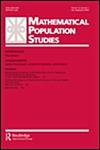logistic脉冲微分方程的正分段连续拟周期解
IF 1.3
3区 社会学
Q3 DEMOGRAPHY
引用次数: 0
摘要
摘要为了证明具有脉冲(其系数具有合理独立周期)的逻辑拟周期微分系统的分段连续解的存在性,将该系统分为微分方程和差分方程。证明了一个函数的拟周期性,证明了该函数是一系列频率总数有限的三角多项式的一致极限。证明了渐近稳定的拟周期正分段连续解的存在性和唯一性。环境的准周期变化导致种群规模的准周期增长,因为系统的合理独立频率也是准周期解的频率。由于渐近稳定性,正解在足够长的时间内具有类似于拟周期解的重复行为。将连续离散系统分离为微分方程和差分方程是证明脉冲系统具有扰动系数的拟周期解存在的一种方法。本文章由计算机程序翻译,如有差异,请以英文原文为准。
Positive piecewise continuous quasi-periodic solutions to logistic impulsive differential equations
ABSTRACT To prove the existence of piecewise continuous solutions to a logistic quasi-periodic differential system with impulses (whose coefficients have rationally independent periods), this system is divided into a differential equation and a difference equation. The quasi-periodicity of a function is proved by showing that this function is the uniform limit of a series of trigonometric polynomials with a finite total number of frequencies. The asymptotically stable quasi-periodic positive and piecewise continuous solution is proved to exist and to be unique. Quasi-periodic variation of the environment leads to a quasi-periodic growth of the population size in the sense that the rationally independent frequencies of the system are also frequencies of the quasi-periodic solution. The positive solutions have a repeated behavior similar to that of the quasi-periodic solution for a sufficiently long time due to asymptotical stability. The separation of the continuous-discrete system into a differential equation and a difference equation is a method of proving the existence of a quasi-periodic solution with perturbed coefficients of the impulsive system.
求助全文
通过发布文献求助,成功后即可免费获取论文全文。
去求助
来源期刊

Mathematical Population Studies
数学-数学跨学科应用
CiteScore
3.20
自引率
11.10%
发文量
7
审稿时长
>12 weeks
期刊介绍:
Mathematical Population Studies publishes carefully selected research papers in the mathematical and statistical study of populations. The journal is strongly interdisciplinary and invites contributions by mathematicians, demographers, (bio)statisticians, sociologists, economists, biologists, epidemiologists, actuaries, geographers, and others who are interested in the mathematical formulation of population-related questions.
The scope covers both theoretical and empirical work. Manuscripts should be sent to Manuscript central for review. The editor-in-chief has final say on the suitability for publication.
 求助内容:
求助内容: 应助结果提醒方式:
应助结果提醒方式:


